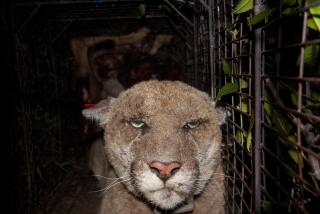PERSPECTIVE ON THE ENVIRONMENT : Unfinished Business: ‘Silent Spring’ : On the 30th anniversary of Rachel Carson’s indictment of DDT, pesticides still threaten human life.
Thirty years after its publication, Rachel Carson’s “Silent Spring” is summarily regarded as the cornerstone of the modern environmental movement. Yet while “Silent Spring” has been heard and debated, it has not been heeded.
Today, nearly five times as many pesticides are manufactured for use in U.S. agriculture, forests and homes and for export than were in 1962. The Environmental Protection Agency has recently detected 74 different pesticides in wells in 38 states. Farm workers in California (many children) have the highest illness and injury rate of any workers in the state. More than 440 insect species are now resistant to certain insecticides. In 1945, 7% of crops were destroyed by insects; in 1990, insects destroyed 13%. Reports this week of the DDT dumping ground off the Southern California coast remind us of the consequences that Carson warned us about.
Six arguments in “Silent Spring” frame this densely documented, toughly argued, yet lyric and compelling indictment of pesticides.
-- The pesticide industry is the progeny of World War II, and pesticide-based agriculture constitutes a virtual “peacetime” war on nature.
-- The system of allowing pesticide residues on food promotes a completely unjustified impression that safe limits have been established and are being adhered to. “What dose of a carcinogen can be safe except a ‘zero’ dose?”
-- The U.S. Department of Agriculture functioned as the major federal promoter of chemical pesticides with its own mass aerial spraying campaigns.
-- Much more money is being invested in research on synthetic chemical insecticides than on naturally occurring biological controls because the former offer patent and profit opportunities that the latter do not.
-- Before 1945, about a dozen species were known to have developed resistance to pre-DDT insecticides. By 1960, as many as 137 species were resistant to the new organic pesticides because of more intensive and more frequent pesticide spraying.
-- The “control of nature” is a phrase conceived in arrogance by men who expect that nature exists for their own convenience and use. Our aim should be to work with nature, not to use brute force.
Carson began the research that ultimately yielded the book “Silent Spring” in the summer of 1957. The state of Massachusetts had aerially sprayed Plymouth County to kill mosquitoes breeding in marshes. The planes crisscrossed over Olga Owens Huckins’ bird sanctuary near the marshes, killing in their non-selective fashion insects, grasshoppers, bees and songbirds. Huckins described to state officials the broad-scale death she found, only to be assured that their tests showed the spray used--DDT in fuel oil--was entirely harmless. She sent an urgent inquiry to Carson asking who in Washington could help.
Carson realized that there would be no peace for herself if she did not speak out against the escalating use of pesticides. What was to be an article took on the proportion of a book; 4 1/2 years later, after reading thousands of technical reports, after detailed consultations with hundreds of American and European scientists, after suffering through a catalogue of illnesses (including cancer) and the death of her mother, she would submit the manuscript to her editor.
Response to the book was charged and polarized. A firestorm of protest from the agri-chemical industry and parts of government swept the country. Carson was called a Luddite, a spinster, a nun of nature; and her work good poetry but poor science. But President John F. Kennedy’s Science Advisory Committee corroborated her findings. The New York Times proposed that Carson receive the Nobel Prize, as had Paul H. Mueller, the Swiss chemist who developed DDT as a pesticide. Eventually, in the early 1970s, the use of DDT was suspended in the United States as a consequence of “Silent Spring.”
Taking DDT off the U.S. market, however, only led to an international traffic in that pesticide. Nearly 50 million pounds of DDT have been manufactured here each year and exported to foreign countries since the chemical was suspended here. It is then imported back on fruits and vegetables in what has been labeled a “circle of poison.”
As for the future of agriculture: Developing herbicide-tolerant plant lines--that is, plants genetically modified to survive being sprayed with an herbicide--constitutes about 40% of U.S. biotechnology research in agriculture. “Silent Spring” merits, on its 30th anniversary, a fresh reading to recast its singular contribution and to take up its unfinished business--an ecology-centered agriculture. Otherwise, it will have won a few battles against the war on nature, but not even a cease-fire.
More to Read
Sign up for Essential California
The most important California stories and recommendations in your inbox every morning.
You may occasionally receive promotional content from the Los Angeles Times.










